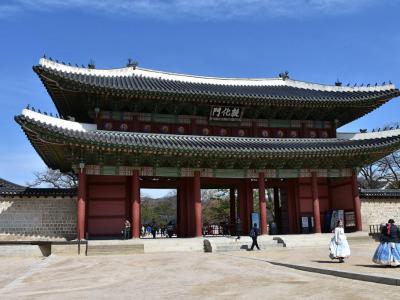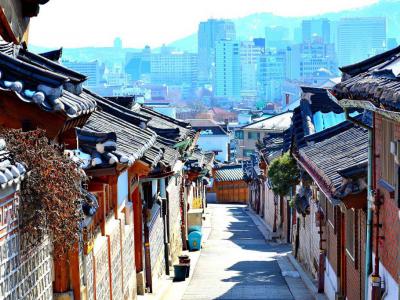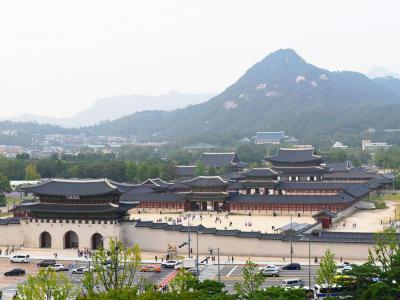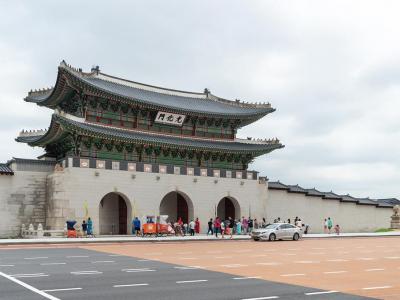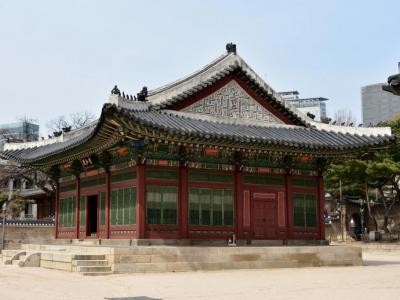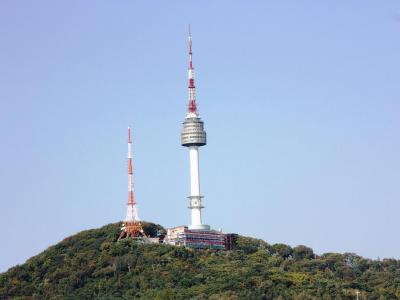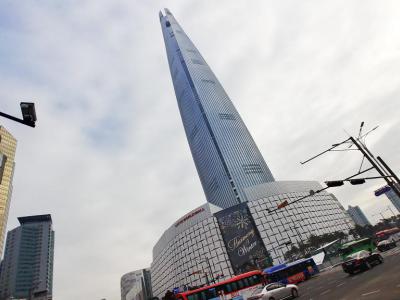Custom Walk in Seoul, South Korea by wsmallrx5288 created on 2025-06-09
Guide Location: South Korea » Seoul
Guide Type: Custom Walk
# of Sights: 7
Tour Duration: 8 Hour(s)
Travel Distance: 21.6 Km or 13.4 Miles
Share Key: VT3Q2
Guide Type: Custom Walk
# of Sights: 7
Tour Duration: 8 Hour(s)
Travel Distance: 21.6 Km or 13.4 Miles
Share Key: VT3Q2
How It Works
Please retrieve this walk in the GPSmyCity app. Once done, the app will guide you from one tour stop to the next as if you had a personal tour guide. If you created the walk on this website or come to the page via a link, please follow the instructions below to retrieve the walk in the app.
Retrieve This Walk in App
Step 1. Download the app "GPSmyCity: Walks in 1K+ Cities" on Apple App Store or Google Play Store.
Step 2. In the GPSmyCity app, download(or launch) the guide "Seoul Map and Walking Tours".
Step 3. Tap the menu button located at upper right corner of the "Walks" screen and select "Retrieve custom walk". Enter the share key: VT3Q2
1) Changdeokgung Palace (must see)
Changdeokgung Palace, also known as Prospering Virtue Palace, has a beautiful setting in one of Seoul's parks. The palace enjoys status as one of the Joseon Dynasty's Five Grand Palaces. One of the noteworthy things about this 15th-century palace is that it blends into the natural topography in a way not commonly seen in other buildings.
The Donhwamun Gate and Geumcheongyo Bridge are two of the oldest structures on the property built in the 15th century. Injeongjeon Hall served as an area for coronations, as well as the reception of envoys. Seonjeongjeon Hall was the location for daily meetings with the king and government ministers, while Juhamnu Pavilion was once the royal library.
Huijeongdang Hall, a residence for the king, and Daejojeon Hall, the queen's residence, are also noteworthy. Yeon-gyeongdang Residence is an 1827 audience hall. Huwon is a garden consisting of 78 acres in the back of the palace.
Changdeokgung Palace is a UNESCO World Heritage Site.
Why You Should Visit:
Although sometimes referred as a 'backup' palace to Gyeongbokgung, the interior is actually more complete. As such, you will be able to have a better understanding of how life in a palace is like. The "Secret Garden" is a must-see.
Tip:
Those wearing 'hanbok' can enter the palace free. You can also buy the Royal Palace Pass that gives you free entrance to 5 palaces (including the 'Secret Garden', which is a highlight of this palace visit).
The Donhwamun Gate and Geumcheongyo Bridge are two of the oldest structures on the property built in the 15th century. Injeongjeon Hall served as an area for coronations, as well as the reception of envoys. Seonjeongjeon Hall was the location for daily meetings with the king and government ministers, while Juhamnu Pavilion was once the royal library.
Huijeongdang Hall, a residence for the king, and Daejojeon Hall, the queen's residence, are also noteworthy. Yeon-gyeongdang Residence is an 1827 audience hall. Huwon is a garden consisting of 78 acres in the back of the palace.
Changdeokgung Palace is a UNESCO World Heritage Site.
Why You Should Visit:
Although sometimes referred as a 'backup' palace to Gyeongbokgung, the interior is actually more complete. As such, you will be able to have a better understanding of how life in a palace is like. The "Secret Garden" is a must-see.
Tip:
Those wearing 'hanbok' can enter the palace free. You can also buy the Royal Palace Pass that gives you free entrance to 5 palaces (including the 'Secret Garden', which is a highlight of this palace visit).
2) Bukchon Hanok Village (must see)
The Bukchon Hanbok Village represents construction methods over 600 years old. The location is on a hilltop, with Changdeok Palace Gyeongbok Palace, and the Jongmyo Royal Shrine surrounding the site. In addition to the hanok-style houses, the village also boasts a network of alleys.
One of the attractions in the village is the Baek In-je's House Museum. This house museum allows you to easily see how these hanok houses are designed and appreciate the traditional features. The museum is easy to tour in 15 to 20 minutes, leaving you with plenty of time to enjoy the rest of the village, filled with exciting photo opportunities.
These houses feature an architectural style not seen in modern homes. Many of these buildings house businesses that are important to the cultural life of the village. Some of these buildings serve as restaurants where you can sample traditional foods, including dishes with ingredients fresh from nearby farms.
Tea houses are also an essential part of local life that you will not want to miss. When you visit a tea house, you can witness tea served in a traditional style. These locations are an essential part of local social life and provide another exciting glimpse into local culture.
Why You Should Visit:
See the centuries-old, unique architecture and take part in unique cultural experiences, a definition of a living history exhibit.
Tips:
Remember that Bukchon Hanok Village is an inhabited residential area today and that not all of the buildings are open to the public. But since many hanoks have been converted to restaurants and tea houses, you can pop-in to order a tea or a meal while enjoy the traditional architecture.
One of the attractions in the village is the Baek In-je's House Museum. This house museum allows you to easily see how these hanok houses are designed and appreciate the traditional features. The museum is easy to tour in 15 to 20 minutes, leaving you with plenty of time to enjoy the rest of the village, filled with exciting photo opportunities.
These houses feature an architectural style not seen in modern homes. Many of these buildings house businesses that are important to the cultural life of the village. Some of these buildings serve as restaurants where you can sample traditional foods, including dishes with ingredients fresh from nearby farms.
Tea houses are also an essential part of local life that you will not want to miss. When you visit a tea house, you can witness tea served in a traditional style. These locations are an essential part of local social life and provide another exciting glimpse into local culture.
Why You Should Visit:
See the centuries-old, unique architecture and take part in unique cultural experiences, a definition of a living history exhibit.
Tips:
Remember that Bukchon Hanok Village is an inhabited residential area today and that not all of the buildings are open to the public. But since many hanoks have been converted to restaurants and tea houses, you can pop-in to order a tea or a meal while enjoy the traditional architecture.
3) Gyeongbokgung Palace (must see)
Gyeongbokgung Palace was built in 1395 by the Joseon Dynasty. This impressive complex served as the Joseon Dynasty's main palace and is the largest of the Five Grand Palaces.
It was destroyed by fire during the Imjin War in 1592 and sat abandoned for over two centuries. In 1867, the palace was reconstructed with 330 buildings and 5,792 rooms. In 1895, Japanese agents assassinated Empress Myeongseong. Emperor Gojong, her husband, left the palace and never returned.
In the early 20th century, Japan's colonial government destroyed palace buildings and constructed the enormous Japanese General Government Building outside the throne hall.
Only a few 19th-century buildings survived the Japanese government and the Korean War. These buildings include Geunjeongjeon (the Imperial Throne Hall), Hyangwonjeong Pavilion, Gyeonghoeru Pavilion, Sujeongjeon Hall, Jagyeongjeon Hall, Sajeongjeon Hall, and Jibokjae Hall.
In 1989, reconstruction began to restore the palace to its former glory. About 40 percent of the building have since been reconstructed or restored.
Geunjeongjeon, the Imperial Throne Hall, is truly impressive. Its constructed mainly of wood and sits in a courtyard lined with stones. Known as rank stones, they indicated where officials of different ranks could stand during ceremonies. The entire courtyard is cloistered.
Gyeongbokgung Palace features dozens of architecturally interesting buildings. Hyangwonjeong, a beautiful hexagonal pavilion, sits attractively on an island.
Why You Should Visit:
Gyeongbokgung Palace is the largest and grandest of the Five Grand Palaces. Visit the National Folk Museum of Korea on the palace grounds to learn about the history of the Korean people. The National Palace Museum of Korea is also located on the palace grounds and houses priceless 14th century Joseon dynasty treasures.
Tips:
You can rent traditional costumes to immerse yourself in 14th-century royal Korea.
For a memorable experience, sign up for a night tour and see the palace lit up. Gyeonghoeru looks spectacular as its warm lights are reflected in the pond.
For a once in a lifetime experience, take part in a Gyeongbokgung Royal Dining event. Sample royal food and watch a traditional performance.
It was destroyed by fire during the Imjin War in 1592 and sat abandoned for over two centuries. In 1867, the palace was reconstructed with 330 buildings and 5,792 rooms. In 1895, Japanese agents assassinated Empress Myeongseong. Emperor Gojong, her husband, left the palace and never returned.
In the early 20th century, Japan's colonial government destroyed palace buildings and constructed the enormous Japanese General Government Building outside the throne hall.
Only a few 19th-century buildings survived the Japanese government and the Korean War. These buildings include Geunjeongjeon (the Imperial Throne Hall), Hyangwonjeong Pavilion, Gyeonghoeru Pavilion, Sujeongjeon Hall, Jagyeongjeon Hall, Sajeongjeon Hall, and Jibokjae Hall.
In 1989, reconstruction began to restore the palace to its former glory. About 40 percent of the building have since been reconstructed or restored.
Geunjeongjeon, the Imperial Throne Hall, is truly impressive. Its constructed mainly of wood and sits in a courtyard lined with stones. Known as rank stones, they indicated where officials of different ranks could stand during ceremonies. The entire courtyard is cloistered.
Gyeongbokgung Palace features dozens of architecturally interesting buildings. Hyangwonjeong, a beautiful hexagonal pavilion, sits attractively on an island.
Why You Should Visit:
Gyeongbokgung Palace is the largest and grandest of the Five Grand Palaces. Visit the National Folk Museum of Korea on the palace grounds to learn about the history of the Korean people. The National Palace Museum of Korea is also located on the palace grounds and houses priceless 14th century Joseon dynasty treasures.
Tips:
You can rent traditional costumes to immerse yourself in 14th-century royal Korea.
For a memorable experience, sign up for a night tour and see the palace lit up. Gyeonghoeru looks spectacular as its warm lights are reflected in the pond.
For a once in a lifetime experience, take part in a Gyeongbokgung Royal Dining event. Sample royal food and watch a traditional performance.
4) Gwanghwamun Gate
Gwanghwamun Gate is main entrance into Gyeongbokgung Palace, and so it is also the largest and most imposing of the four gates. It features three grand arched gates--the center gate was reserved for use by the king, while the crown prince and royal officials used the other two smaller arches.
The tall granite structure of the gate supports the ornately decorated wooden gate tower, which watches over the city. The pavilon housed a bell that announced the time of the day to the city. Two majestic Haetae sculptures guard the gate. These mythical lion-like beasts were stationed there to protect the palace against fire.
Gwanghwamun Gate was one of only four gates constructed in the palace walls. They were originally constructed in 1395 during the reign of King Taejo of the Joseon Dynasty. But the gates and walls have been through many cycles of destruction and reconstruction.
It was destroyed by fire during the Imjin Wars in 1592 and laid in ruins until it was rebuilt in 1867. In 1926, the Japanese government moved Gwanghwamun Gate. The double-roofed wooden pavilion on the gate was destroyed during the Korean War. The gate was moved again in 1968.
Gwanghwamun Gate was moved back to its original location in 2006, and the restoration was completed in 2010. The restoration included recreating the base with traditional materials, recreating the original wooden pavilion structure with Korean pine, and recreating the wooden nameplate.
The area in front of Gwanghwamun Gate is known as Gwanghwamun Plaza. Here, visitors can watch the impressive royal changing of the guard ceremony. This ceremony is held daily, every hour, on the hour, from 10:00 to 15:00.
Tip:
The square housing the gate contains fountains, statues and sculptures that are also definitely worth seeing, plus an underground museum dedicated to Sejong the Great, the 4th king of the Joseon Dynasty.
The tall granite structure of the gate supports the ornately decorated wooden gate tower, which watches over the city. The pavilon housed a bell that announced the time of the day to the city. Two majestic Haetae sculptures guard the gate. These mythical lion-like beasts were stationed there to protect the palace against fire.
Gwanghwamun Gate was one of only four gates constructed in the palace walls. They were originally constructed in 1395 during the reign of King Taejo of the Joseon Dynasty. But the gates and walls have been through many cycles of destruction and reconstruction.
It was destroyed by fire during the Imjin Wars in 1592 and laid in ruins until it was rebuilt in 1867. In 1926, the Japanese government moved Gwanghwamun Gate. The double-roofed wooden pavilion on the gate was destroyed during the Korean War. The gate was moved again in 1968.
Gwanghwamun Gate was moved back to its original location in 2006, and the restoration was completed in 2010. The restoration included recreating the base with traditional materials, recreating the original wooden pavilion structure with Korean pine, and recreating the wooden nameplate.
The area in front of Gwanghwamun Gate is known as Gwanghwamun Plaza. Here, visitors can watch the impressive royal changing of the guard ceremony. This ceremony is held daily, every hour, on the hour, from 10:00 to 15:00.
Tip:
The square housing the gate contains fountains, statues and sculptures that are also definitely worth seeing, plus an underground museum dedicated to Sejong the Great, the 4th king of the Joseon Dynasty.
5) Deoksugung Palace
Deoksugung Palace is the smallest of the Five Grand Palaces built by the Joseon Dynasty. This residence became a royal palace after the other palaces burned in 1592. King Gwanghaegun and King Injo were crowned in Jeukjodang Hall in the 1600s.
Deoksugung Palace was heavily damaged during colonial rule. The palace is now only about one-third of its original size. Hamnyeongjeon Hall was the sleeping residence for King Gojong after he moved to the palace in 1897.
Deoksugung Palace has many interesting architectural features. It includes buildings made from stucco, stone, and wood with architectural style blend eastern and western designs. Visitors will also find a beautiful western-style garden and fountain.
The neoclassical Seokjojeon Hall was built in 1910. With its triangular roof and tall collonades, this building is a striking departure from traditional Korean architecture. The Daehan Empire History Museum is located inside Seokjojeon Hall.
Jeonggwanheon, built around 1910, combines eastern and western styles. Kings in the Joseon Dynasty had their portraits enshrined here.
Don't miss the colorful changing of the guard outside Daehanmun Gate.
Why You Should Visit:
This is the only palace in Seoul where you can take photos with the Royal Guards after the changing ceremony. Unlike other palaces, you can also enter the grounds at night to enjoy a moonlit stroll. Beyond the palace, you can explore the historic neighborhood and the famous Stonewall Walkway along the palace walls.
Tip:
Going inside the castle, you'll need to pay a fee, unless you're wearing a 'hanbik' – then it's free!
Make sure you check out the Jeongdong Observatory, located next door to the palace. From the observation deck (18th floor) you can capture panoramic views of the Deoksugung Palace grounds, CBD skyline, City Hall grounds and other landmarks – and its free! You'll get some amazing photos as a souvenir.
Deoksugung Palace was heavily damaged during colonial rule. The palace is now only about one-third of its original size. Hamnyeongjeon Hall was the sleeping residence for King Gojong after he moved to the palace in 1897.
Deoksugung Palace has many interesting architectural features. It includes buildings made from stucco, stone, and wood with architectural style blend eastern and western designs. Visitors will also find a beautiful western-style garden and fountain.
The neoclassical Seokjojeon Hall was built in 1910. With its triangular roof and tall collonades, this building is a striking departure from traditional Korean architecture. The Daehan Empire History Museum is located inside Seokjojeon Hall.
Jeonggwanheon, built around 1910, combines eastern and western styles. Kings in the Joseon Dynasty had their portraits enshrined here.
Don't miss the colorful changing of the guard outside Daehanmun Gate.
Why You Should Visit:
This is the only palace in Seoul where you can take photos with the Royal Guards after the changing ceremony. Unlike other palaces, you can also enter the grounds at night to enjoy a moonlit stroll. Beyond the palace, you can explore the historic neighborhood and the famous Stonewall Walkway along the palace walls.
Tip:
Going inside the castle, you'll need to pay a fee, unless you're wearing a 'hanbik' – then it's free!
Make sure you check out the Jeongdong Observatory, located next door to the palace. From the observation deck (18th floor) you can capture panoramic views of the Deoksugung Palace grounds, CBD skyline, City Hall grounds and other landmarks – and its free! You'll get some amazing photos as a souvenir.
6) Namsan Tower (N Seoul Tower) (must see)
Namsan Tower, officially known as N Seoul Tower, was completed in 1971 as South Korea’s first general broadcast tower. It initially served to transmit television and radio across the capital. Since opening to the public in 1980, it has transformed into a cherished landmark symbolizing Seoul’s blend of history, romance, and modernity.
At 236.7 m tall, and with the summit of Namsan Mountain itself at approximately 243 m above sea level, the tower offers sweeping views rising to nearly 480 m above sea level. Multiple observation decks provide 360° vistas of the skyline-from historic palaces and ancient city walls to modern skyscrapers and the Han River. The upper floors even feature distance markers pointing out cities and landmarks across the world.
Beyond the views, N Seoul Tower is known for its cultural touches and romantic atmosphere. Visitors can walk past the famous Locks of Love, where couples leave padlocks on the fences as a symbol of everlasting affection-though these locks are sometimes cleared to maintain the tower’s function. Inside, the building comprises multiple levels: the N Lobby hosts a museum, café, and theatre for children; N Plaza includes souvenir shops, media art experiences, and the love‑lock terrace; while N Tower encompasses observation decks, restaurants like Hancook, and a revolving French restaurant, N Grill, offering gourmet meals and panoramic views as it completes a full turn every ~48 minutes.
At night, the tower is illuminated in changing LED colors that reflect air quality-shifting from serene blue to green, yellow, and red-adding a modern eco‑awareness twist to its aesthetic appeal. With around 8 to 12 million annual visitors, it remains one of South Korea’s most beloved and enduring tourist attractions.
At 236.7 m tall, and with the summit of Namsan Mountain itself at approximately 243 m above sea level, the tower offers sweeping views rising to nearly 480 m above sea level. Multiple observation decks provide 360° vistas of the skyline-from historic palaces and ancient city walls to modern skyscrapers and the Han River. The upper floors even feature distance markers pointing out cities and landmarks across the world.
Beyond the views, N Seoul Tower is known for its cultural touches and romantic atmosphere. Visitors can walk past the famous Locks of Love, where couples leave padlocks on the fences as a symbol of everlasting affection-though these locks are sometimes cleared to maintain the tower’s function. Inside, the building comprises multiple levels: the N Lobby hosts a museum, café, and theatre for children; N Plaza includes souvenir shops, media art experiences, and the love‑lock terrace; while N Tower encompasses observation decks, restaurants like Hancook, and a revolving French restaurant, N Grill, offering gourmet meals and panoramic views as it completes a full turn every ~48 minutes.
At night, the tower is illuminated in changing LED colors that reflect air quality-shifting from serene blue to green, yellow, and red-adding a modern eco‑awareness twist to its aesthetic appeal. With around 8 to 12 million annual visitors, it remains one of South Korea’s most beloved and enduring tourist attractions.
7) Lotte World Tower and Mall
Soaring beside Seokchon Lake in Jamsil, Lotte World Tower & Mall is an awe-inspiring destination for visitors to Seoul. At a staggering 555 m tall with 123 stories, it's the tallest building in South Korea and currently ranks as the sixth‑tallest in the world. Completed in 2017, this sleek, tapered tower designed by Kohn Pedersen Fox draws design inspiration from Korean pottery and traditional brush strokes, blending high-tech engineering with cultural aesthetics.
The crown jewel of the tower is the Seoul Sky Observatory, located on floors 117–123. It features a 360° deck, thrill-inducing glass floor sections, and even an open-air Sky Terrace-offering panoramic views of Seoul and the Han River 500 m above the city. Visitors can also experience the Sky Shuttle, one of the world’s fastest double-deck high-speed elevators, whisking guests skyward in under a minute.
Connected seamlessly to the tower is the expansive Lotte World Mall, which opened in 2014. It offers a mix of international and Korean brands across multiple shopping zones, including Avenuel, Duty-Free, and Lotte Mart. Entertainment options are abundant: the Lotte World Aquarium, the Lotte Cinema, largest multiplex in Korea, a contemporary Art Museum, and the Lotte Concert Hall complete this multi-faceted complex.
The crown jewel of the tower is the Seoul Sky Observatory, located on floors 117–123. It features a 360° deck, thrill-inducing glass floor sections, and even an open-air Sky Terrace-offering panoramic views of Seoul and the Han River 500 m above the city. Visitors can also experience the Sky Shuttle, one of the world’s fastest double-deck high-speed elevators, whisking guests skyward in under a minute.
Connected seamlessly to the tower is the expansive Lotte World Mall, which opened in 2014. It offers a mix of international and Korean brands across multiple shopping zones, including Avenuel, Duty-Free, and Lotte Mart. Entertainment options are abundant: the Lotte World Aquarium, the Lotte Cinema, largest multiplex in Korea, a contemporary Art Museum, and the Lotte Concert Hall complete this multi-faceted complex.
